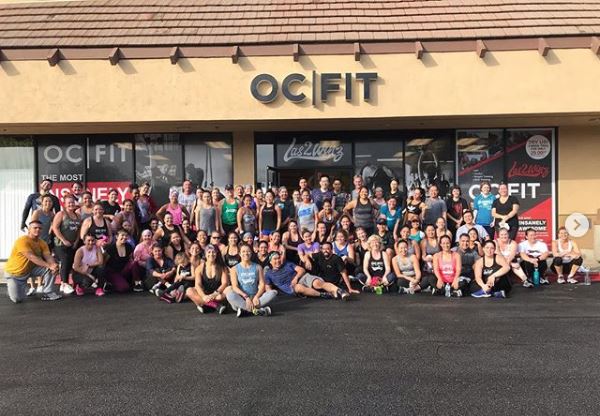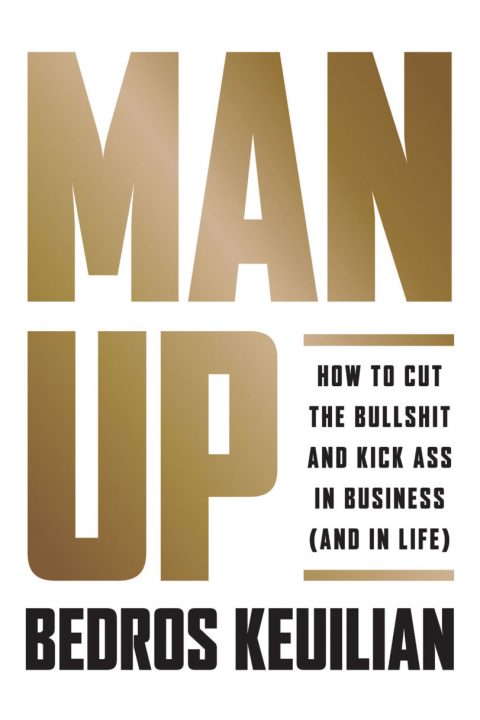Reporting a 169 percent increase in sales for 2018, LIFEAID Beverage Company announced last week it is aiming to triple its retail presence to at least 18,000 doors this year, including Walmart, Whole Foods, Kroger, and Sprouts stores.
The announcement comes as the company prepares to expand chainwide at Walmart with its FitAid, FocusAid, and ImmunityAid SKUs, as the retailer looks to grow its functional beverage set with national and regional brands.
LIFEAID VP of Sales Dan Leja told BevNET, "The company entered 429 stores Walmart last year and that the expansion marks a ten-fold increase."
The company has also expanded in Kroger; according to Leja, LIFEAID has experienced a “natural evolution” with the retailer, having first entered with a 40-store test in the Texas market in 2016 and slowly expanded over the past two years. The latest expansion brings the brand’s presence to 15 Kroger divisions, which Leja said is about 1,500 doors.
LIFEAID has also reformulated its nootropic-based FocusAid line to double its caffeine content to 100 mg per can. Leja said the SKU is projected to grow more than 500 percent in 2019 and will make up 40 percent of the company’s total placement.
Leja said the company is also seeking to increase brand awareness by working with “micro influencers” who can appeal to the company’s niche target demographics. LIFEAID will seek to grow its FitAid line within yoga studios, while the company is recruiting musicians and DJs to promote its PartyAid line.
“We really want to piggyback off of what we’ve done with FitAid and building the name within the Crossfit and functional fitness space,” Leja said. “It’s not gimmicky or anything like that. We’re truly passionate about the offerings that we have and we want to portray that in a professional manner.”
On the West Coast, LIFEAID is also building out its DSD network to service the convenience channel, working with distributors Hensley in Arizona, Golden Beverage in Utah, Bonanza in Nevada, and New Age in Colorado. The company is negotiating contracts currently to service the entirety of California and the Pacific Northwest.
“By building out this proof of concept we wanted a story we could take to distributors and not just sell them on hopes and dreams,” he said. “Most of our retail authorizations started in the west, so that’s why we’re building our DSD footprint there. We also have some high-level meetings coming up in the Northeast in the coming weeks to start carving out a DSD footprint there as well.”
Visit lifeaidbevco.com for more information about the brand, or to shop the entire lineup of their clean nutritional blends to fit your active lifestyle.

Source: on BevNet.com - Jan. 31, 2019 at 6:41 p.m.
Reporting a 169 percent increase in sales for 2018, LIFEAID Beverage Company announced last week it is aiming to triple its retail presence to at least 18,000 doors this year, including Walmart, Whole Foods, Kroger, and Sprouts stores. The announcement comes as the company prepares to expand chainwide at Walmart with its FitAid, FocusAid, […]
Twin sisters from Colombia share a glimpse into the struggle and perseverance which brought them to America, and the strength it took to help them build their lives as extreme fitness athletes and personal trainers.
Natalia & Margarita Guzman (best known on social media as @Las2winz) migrated to the United States from Tunja, Colombia in June of 2001. Living in fear, with the family receiving daily life threats, their parents made the decision to move away from Colombia in search of a safer life in the United states.
June 15, 2001, was the day the twin sisters' lives would change forever.
Speaking zero English, the Guzmans left their families behind and their parents sold their business, basically restarting their lives from scratch. Everything their parents worked so hard for their entire lives was (poof!) gone.
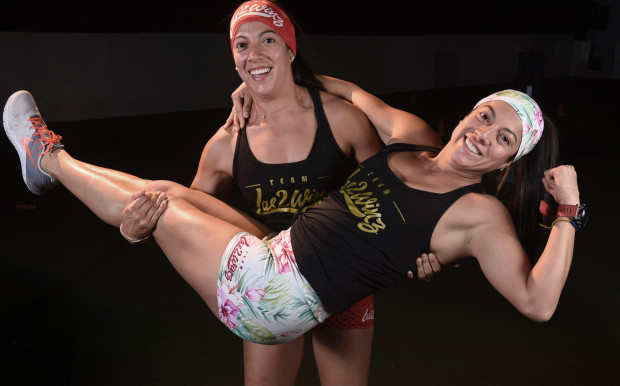
To say they experienced culture shock in the United States would be a severe understatement. The Guzmans went from living in a 3-bedroom house to a 2-bedroom apartment. Their parents, Juan and Esperanza, went from owning their own business to working low-income jobs just to pay the bills. The hardest part of moving to the U.S. was the language barrier — not being able to understand or communicate with anyone.
“We were bullied a lot,” Margarita admits. “People made fun of how we spoke. There were not many friends.”
Growing up as non-English-speaking immigrant students proved very challenging and oftentimes lonely, as the girls struggled to make friends amidst such a thick language barrier. As middle schoolers, Natalia and Margarita were teased simply for the way they spoke, leading to many insecurities. They also endured the struggles of watching both of their parents work jobs they did not love — such as delivering bouncy houses to parties on the weekends, newspaper routes in the early mornings and cleaning offices late at night.
The pain of watching their parents fall from the position of business owners to working low-paying jobs proved both heartbreaking and motivating.
At the age of 15, both Natalia and Margarita started working, eventually working their way through college. Juggling full-time jobs and a full college course load was no easy task for either of them, but they managed to graduate from CSU-Long Beach in 2004, with Business degrees in Finance. Soon after graduating, they both began working out and ended up getting jobs as personal trainers at a bootcamp called OC|FIT.
"It was in that environment (at OC|FIT) that we found our passion and calling. We were meant to inspire, motivate and change people’s lives through fitness."
For the next four years, the Guzman sisters went on to be trainers and manage one of OC|Fit's five locations. This helped Natalia build up enough courage to open our own (sixth) location of OC|Fit on April 2, 2018. With the support of their clients, both of their savings and their parents' life savings, the Guzman girls suddenly went from working for someone else to owning their own business in the United States of America.
"We can proudly say that we have achieved the American Dream. We started from nothing with nothing and built a successful gym that changes lives every single day," says Margarita.
Their hard work, tenacity, discipline, motivation and drive to succeed propelled the Guzmans to become Latina women business owners.
As fitness enthusiasts, the twins have also completed extreme obstacle course races in Las Vegas, Dallas, San Francisco, Lake Tahoe, Oahu and Seattle.
"Every day we are living the American Dream, and we have our parents to thank for that. Everyone is given the ability to make their dreams a reality, it is up to each of us to get out there, work hard, and make it happen."
Twin sisters Margarita & Natalia (@Las2winz) are not just living the American Dream,
their story is inspiring others to ...
dream big!
To learn more about OC|Fit, visit OCFitGames.com or follow the Guzman sisters on Instagram: @las2winz
> > > Live well.
Top photo credit: Bill Alkofer, Orange County Register/SCNG
Twin sisters from Colombia share a glimpse into the struggle and perseverance which brought them to America, and the strength it took to help them build their lives as extreme fitness athletes and personal trainers. Natalia & Margarita Guzman (best known on social media as @Las2winz) migrated to the United States from Tunja, Colombia […]
With a customer satisfaction rating of 95%, the customer service team at LIFEAID Beverage Co. must be doing something right!
Every quarter, the team of nearly half a dozen customer service team members reads a book and discusses it together — sharing their insights, questions and takeaways. Topics range from motivation, customer service, team-building, humorous life lessons, positive habits and everything in between. Inevitably, the team walks away with a better understanding of how to be the best possible version of themselves — at work and in their personal life.
In this edition of A Better Way to Think, your LIFEAID customer service team bookworms Jade, Rose & Steven tackle The 7 Habits of Highly Effective People by Stephen Covey. Here's what they had to say about the book and how it changed each of their lives ...
PART 1 - Intro: PARADIGMS AND PRINCIPLES
Rose’s Takeaway: This chapter brings up how traditional literature regarding effectiveness is superficial, providing only quick fixes and social bandaids that mask chronic problems.
In order to achieve long-term success, you must put the work in and take no shortcuts along the way.
Perceptions govern the way we see, and how we see governs how we behave. So we must change the lens through which we see the world before we can change the reality of what's on the other side of the lens.

HABIT 1: Be Proactive
Jade’s Takeaway: "Proactivity" is defined by Covey as the following: “We have the initiative and responsibility to make things happen.” There are three “social maps” or theories of determination that are thought to influence or determine an individual's life. These are Genetic Determinism (you are the way you are because of your genes and ancestry), Psychic Determinism (your childhood and upbringing laid out your personal tendencies and character structure), Environmental Determinism (factors in your environment and surroundings are responsible for your situation).
The philosopher and holocaust survivor Viktor Frankl came to a realization amidst unbelievable horrors and tragedy, saying,
“Man has the freedom to choose, using self-awareness, imagination, conscience, and independent will.” Between stimulus and response is the power to choose.
This means that the individual has the ability to choose how they respond to stimulus and circumstance. The ability to be “Response-able” to be proactive. Highly productive people recognize responsibility — their behavior is a product of their own conscience choices, based on values rather than a product of their circumstances. “I am not a product of my circumstances. I am a product of my decisions.” Proactive people focus on their “circle of influence,” the things that they can do something about. Reactive people focus on their “circle of concern” — focusing on the things that they have little to no control over. Gaining an awareness over the areas in which we can expand our energies is a step in becoming proactive.
“The commitments that we make to ourselves and others and our integrity to those commitments is the essence of our growth and the clearest manifestation of our proactivity”
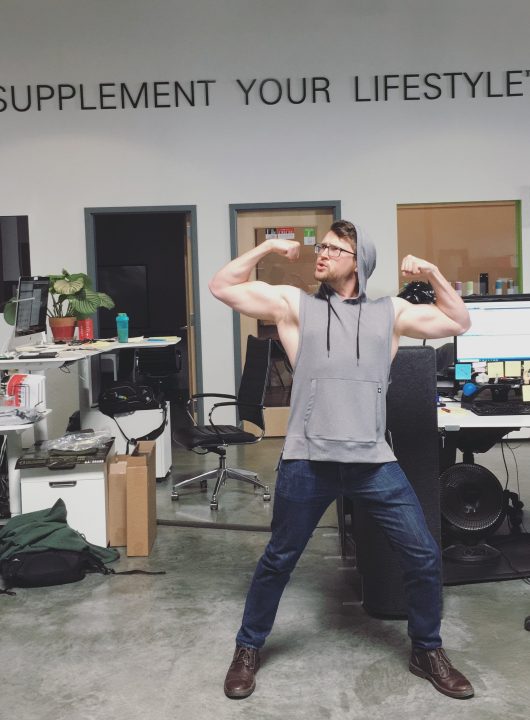
Rose's Takeaway: What matters most is how we respond to what we experience in life. It’s not the doing of others or even our own mistakes that hurt us, but how we react to them. The idea that the problem is out there, with others or circumstances, is the problem itself. Learn to view the weaknesses of others with compassion, not accusation. This section also touches on something I found powerful: “Love is a Verb.” Love is an action, the feeling follows.
HABIT 2: Begin with the End in Mind
Steven’s Takeaway: Beginning with the end in mind ensures you don’t violate the criteria you have defined as supremely important in life. You must start with a clear understanding of your destination and know where you are going so that you better understand where you are now and the steps need to get there. In addition, this concept is based around the principle that “all things are created twice.” The first creation is leadership, carefully thinking through business endeavors. The second creation is management, the organizing of all elements to meet the objective. Effectiveness does not depend solely on how much effort we expend, but on whether or not the effort is focused in the right areas.
“Management is doing things right, leadership is doing the right things.”
A Personal Mission Statement is the most effective way to begin with the end in mind. We must begin in the center of the circle of influence which is composed of our most basic paradigms. The center is sourced by security (sense of worth), guidance (source of direction), wisdom (perspective on life), and power (capacity to act). When these four things are harmonized they create a great force. An effective Organizational Mission Statement is one that reflects the shared vision and values of everyone within that organization, creating unity and tremendous commitment.

HABIT 3: Put First Things First
Rose, Jade & Steven's Takeaways: Habit 3 is the fulfillment of habits 1 and 2. Habit 1 says you are the creator, it empowers you to say that is an unhealthy program I’ve been given, an ineffective script that I can change. Habit 2 is the first mental creation, based on the ability to envision. Create with our minds what we cannot presently see with our eyes. Habit 3 is the physical creation, the natural emergence of habits 1 and 2. The Power of Independent Wealth: Manage from the left, lead with the right. Effective management is putting first things first. While leadership decides what the first things are, management is the discipline to carry things out. Discipline is a function of independent will, it comes from within.
Time = Efficiency / People = Effectiveness
Delegation plays a big part in effective management.
“Effective people are not problem minded. They feed opportunities and starve problems” — LIFEAID core value: Be solution-oriented, not problem-focused.
HABIT 4: Think Win, Win
Steven’s Takeaway: Private victory precedes public victory. “Until we stop treating the symptoms and start treating the problem, our efforts will only bring counterproductive results.” Move away from the “quick-fix” band-aids.
The Emotional Bank Account is an important concept to help establish and maintain healthy relationships with friends, colleagues, customers, etc.
Rose’s Takeaway: There is no quick fix to building or repairing relationships, they are long term investments. Make deposits into people's emotional bank accounts by seeking to understand what’s important to the individual, make what's important to the other person as important to you as that person is to you. Tend to the little things, keep commitments, show personal integrity and clarify expectations to avoid miscommunication.

HABIT 5: Seek First to Understand, Then to Be Understood
Rose’s Takeaway: First diagnose, then prescribe. To interact with someone effectively, you must first understand them. If you are using some sort of technique, the person will sense duplicity and manipulation. The key to influence is is your example, if your private performance doesn’t doesn’t square up with your public performance, a person is likely to not open up to you. We typically seek first to be understood. Empathic listening is listening with intent to understand. Empathic listening is powerful because it gives you data to work this, listening in itself is a tremendous deposit into one's emotional bank account. It is deeply therapeutic and healing because it gives the person psychological air.
HABIT 6: Synergize
Jade’s takeaway: Synergy is the essence of principle-centered leadership. Synergy can be defined as the whole is greater than the sum of its parts. Factors coming together to make something greater. LIFEAID is a prime example of synergy. Different departments and assets coming together to make something greater than anyone component. An example of synergistic communication at LIFEAID is the weekly department head meeting. Coming together to discuss and find ways to find win, win solutions to various roadblocks within each department, helping team members reach their goals. The same thing can be said for the weekly Customer Service meetings. An effective company needs to be synergistic. Everybody brings something to the table.
HABIT 7: Sharpen the Saw & Inside-Out Again
Rose & Steven's Takeaways: Sharpening the saw. Take all the habits we’ve discussed and apply them all to your life. Covey compares training your patience to building muscle in the gym. The growth happens during those last few repetitions — when the nerve fiber registers pain, the fiber is then made stronger. If it happens to be raining on a morning you had planned to take a jog, simply think, “Oh great, this is an opportunity for me to exercise my patience and willpower as well as train.” At LIFEAID, we are constantly encourage to remain active and take care of our bodies.
The four dimensions we sharpen are: physical, spiritual, mental and social/emotional. Your spiritual dimension is your core. “If ones motives are wrong, nothing can be right.” As long as you feel you are serving others, you do the job well. When you are concerned only with helping yourself, you do the job less well. Character can’t be made except by a steady continued process.
“When we take the time to draw on the leadership center of our lives ... it spreads like an umbrella over everything else. It renews us, it refreshes us.”
A B O U T T H E T E A M :
Rose and Steven have been valuable members of the LIFEAID customer service team since 2017.
Jade has been the LIFEAID customer service team captain since 2016.
Stephen R. Covey's best-selling book is available for purchase online & at local bookstores nationwide.
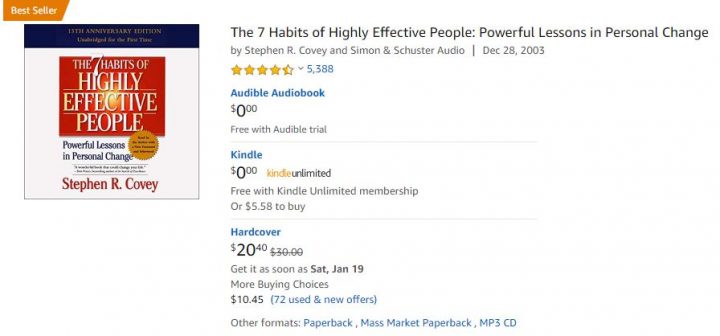
> > > Live well.
With a customer satisfaction rating of 95%, the customer service team at LIFEAID Beverage Co. must be doing something right! Every quarter, the team of nearly half a dozen customer service team members reads a book and discusses it together — sharing their insights, questions and takeaways. Topics range from motivation, customer service, team-building, humorous […]
By: Karenia Bowman |
Nothing says "cozy winter comfort food" quite like beef stew.
If you know me, you know there's nothing I love more than family gatherings, valid excuses for being extra festive, and healthier takes on our favorite comfort foods. My husband is a comfort food guy through and through, so naturally I eat up every ounce of his unrestrained enthusiasm when I make one of the classics. According to my husband, Hearty Beef Stew is the holy grail of comfort food. When I make him his beloved hearty beef stew, nothing else in the world matters to him except for those deliciously tender chunks of beef, velvety smooth pillows of potato along with the ensemble of stew veggies that melt in your mouth with each and every bite. We can’t forget about that deep, rich, savory sauce … because it’s all about the sauce. I think it’s pretty safe to say that when it comes to feeding a true comfort food connoisseur, saucy beefy things are a BIG DEAL.
You might be asking, “How can I make a healthier version of such a serious classic without sacrificing my lifestyle goals?”
Easily. With a few strategic swaps, you can enjoy comforting favorites like this beef stew. Instead of purchasing the fattier cuts of stew meat, opt for extra lean cuts. You will drastically reduce the fat and calories without sacrificing flavor. My other strategic swap involves thickening the sauce. A lot of stew recipes use white flour as the main thickening agent. I have nothing against white flour, but with gluten intolerance and/or sensitivity on the rise, I always look for convenient alternatives such as cornstarch, which is inexpensive and readily available.
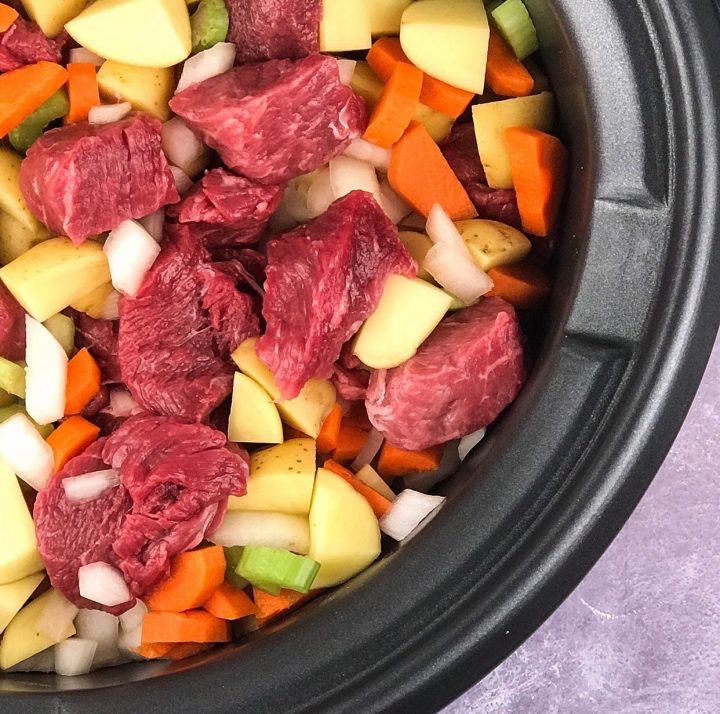
This recipe is all about convenient home cooked comfort food. No endless hours in the kitchen, no huge pile of dirty dishes that will not do themselves, just some minor chopping, mixing and setting the slow cooker. Whether your days and nights are filled with some seasonal festive fun, or you’re heading to the gym for a much needed workout at the end of a busy day, or you simply can’t cook but you have to eat something to stay alive, the slow cooker can and will be your best friend here.
Even though many of us love this time of year, we are often exhausted by the end of each day. Endless parties and gatherings, holiday events and obligations, the struggle to maintain the balance of a healthy lifestyle in the midst of abundant temptation, and the excitement of the season followed by the inevitable burnout, are all very real experiences we may encounter. As the holidays get closer and our days and evenings get busier, coming home to cook a labor intensive meal is the last thing we want to do. It’s okay to make things a little (or a lot) easier on yourself. Plug in your slow cooker with pride, and let it do the work for you … You can even skip the dishes.
All you need to do is pull up a chair and serve yourself up a generous bowl of this hearty, savory stew to soothe your soul, and fill your belly at the end of a long, eventful day.

Hearty Slow Cooker Beef Stew
Gluten-free, high-protein, low-fat
Servings: 6 | 282 calories per serving
27g Protein | 28g Carbs | 4g Fat
Ingredients
1.5 lb. extra lean stew meat, trimmed and cubed
1 lb. Dutch baby or red potatoes, quartered
1 cup yellow onion, diced
1 cup celery, chopped
1.5 cups carrot, peeled and sliced into rounds
2 garlic cloves, minced
1 cup dry red wine
1 cup reduced sodium beef broth, gluten free
2 Tablespoons tomato paste, whisked in broth
1/4 cup cornstarch, dissolved in 1/4 cup cold water
2 bay leaves
1.5 teaspoons dried thyme
Kosher salt & coarse ground pepper, to taste
Preparation
- Place the trimmed stew meat in the slow cooker. Quarter the baby potatoes, dice the onion, chop the celery, slice the peeled carrots and mince the garlic cloves, then add them to the slow cooker. Pour wine over the meat and vegetable mixture. Whisk the tomato paste in the beef broth until smooth, then pour the mixture into the slow cooker cavity. In a small ramekin, combine 1/4 cup of cold water and cornstarch. Gently stir until the cornstarch has dissolved. Stir the cornstarch mixture into the slow cooker. Add the bay leaves and dried thyme, then season the stew mixture with salt and pepper. Cover the stew with a lid and turn the heat on the low setting, and let cook for 6-8 hours, stirring occasionally.
- When the stew is done, remove the bay leaves. Adjust the salt and pepper to taste preferences and enjoy immediately, or transfer to an airtight storage container and store in the refrigerator for later.
> > > Live well.
By: Karenia Bowman | Nothing says “cozy winter comfort food” quite like beef stew. If you know me, you know there’s nothing I love more than family gatherings, valid excuses for being extra festive, and healthier takes on our favorite comfort foods. My husband is a comfort food guy through and through, so naturally I eat […]
New research uncovers fresh evidence to suggest that frequent exposure to negative emotions may have an important impact on the functioning of the immune system.
Do you often feel sad or angry? This could affect how your body reacts, researchers warn.
Many studies have shown that chronic exposure to stress, anxiety, and negative moods generally can affect physical health to a large extent.
As Medical News Today reported only last year, researchers have found that chronic stress has a negative impact on memory.
Also, feelings of distress can raise the risk of cardiovascular events, such as stroke.
Now, a study conducted by specialists from Pennsylvania State University in State College has found that negative moods may change the way in which the immune response functions, and they are associated with an increased risk of exacerbated inflammation.
The results of the research — which was led by Jennifer Graham-Engeland, an associate professor at Pennsylvania State University — appear in the journal Brain, Behavior, and Immunity.
Negative moods and inflammation
The scientists collected the data for the study via a two-tiered approach. They used questionnaires that asked participants to record their feelings over time and in the moment. These assessments took place over 2 weeks and allowed the team to map out the participants' emotional profiles.
The scientists also assessed the immune response of the volunteers by collecting blood samples from them and looking for markers of inflammation.
Inflammation occurs naturally, as part of the immune response, when the body reacts to infections or wounds. However, high levels of inflammation are associated with poor health and a range of chronic conditions, such as arthritis.
Graham-Engeland and team noticed that individuals who experienced negative moods several times per day for extended periods of time tended to have higher levels of inflammation biomarkers in their blood.
The scientists also note that if they collected blood samples from participants soon after they had experienced a negative emotion such as sadness or anger, inflammation biomarkers were all the more present in the blood.
However, experiencing positive moods — even for a short while before the collection of a blood sample — was associated with lower inflammation levels. However, this was only true for male participants in this study, the investigators specify.
'Affect is modifiable'
The scientists are confident that their study adds crucial evidence regarding the impact of negative affect on health — especially since their participants belonged to diverse ethnic, racial, and socioeconomic backgrounds.
Nevertheless, they caution that to confirm these findings, they will need to replicate them in further studies. They point out that the recent research was the first to explore the link between both momentary and long-term mood reports and measures of inflammation.
"We hope that this research will prompt investigators to include momentary measures of stress and affect in research examining inflammation, to replicate the current findings and help characterize the mechanisms underlying associations between affect and inflammation," explains Graham-Engeland.
In the future, they hope that this and similar studies may allow specialists to come up with better strategies to improve mood and thus protect aspects of physical health.
"Because affect is modifiable, we are excited about these findings and hope that they will spur additional research to understand the connection between affect and inflammation, which in turn may promote novel psychosocial interventions that promote health broadly and help break a cycle that can lead to chronic inflammation, disability, and disease."
—Jennifer Graham-Engeland
Source: Medical News Today
— Published
For information about the IMMUNITYAID Support Blend which contains essential vitamins and clean ingredients your body's immune system needs to stay defended daily, visit our product page here.
> > > Live well.
New research uncovers fresh evidence to suggest that frequent exposure to negative emotions may have an important impact on the functioning of the immune system. Do you often feel sad or angry? This could affect how your body reacts, researchers warn. Many studies have shown that chronic exposure to stress, anxiety, and negative moods generally can affect […]
Dieters looking to stick to their New Year's resolutions need look no further than their local Chipotle.
The burrito restaurant introduced a collection of "lifestyle bowls" earlier this week, available exclusively through its mobile app and website. The new offerings use the same ingredients that Chipotle has always offered, but are catered to folks adhering to the popular keto, paleo, Whole30 and other protein-rich diet plans.
The online-only availability of these meals is a strategic move by the company to coax more customers to order digitally, since average checks of digital orders tend to be higher than orders placed at the restaurant.
The bowls are a bit pricier than a traditional bowl as they all contain guacamole or double the meat, both extra charges at the chain. Without add-ons, salads and bowls cost between $7.60 and $8.60, as priced at a New Jersey Chipotle restaurant. In comparison, these lifestyle bowls run from $10.30 to $11.15.
The appeal of the bowls is that dieters don't need to build their own or try and figure out what items fit their diet plan, Chipotle does it for them.
Read the full article here.
Source: CNBC |By Sarah Whitten
> > > Live well.
Dieters looking to stick to their New Year’s resolutions need look no further than their local Chipotle. The burrito restaurant introduced a collection of “lifestyle bowls” earlier this week, available exclusively through its mobile app and website. The new offerings use the same ingredients that Chipotle has always offered, but are catered to folks adhering to […]
We’ve all heard the expression, “Do what you love and you’ll never work a day in your life.”
1. Teach in three places or less.
You cannot be everywhere, so don’t try. Focus on finding two or three (one, if you’re lucky) “yoga homes” where you enjoy practicing, teaching, and connecting with the community. Make sure your “homes” are not struggling and can compensate you appropriately for the work you put in. Negotiate your pay so you feel comfortable with what you receive for your efforts. Even as a newer teacher, you still deserve to be paid competitively for your work.
2. Pursue teaching in corporate environments.
I never thought teaching in an office setting would be one of my favorite places to work, but they are genuinely the best. Pros: students are delighted to have a break from their desk; pay is consistent and often higher than in a studio or gym setting; your work is valued and appreciated in a professional way. Also, snacks.
3. Prioritize quality over quantity.
As an East Coast Jew, my go-to is: Always do more and say "yes!" to opportunities. However, this has come back to crush me many times during my career. As a teacher, you must learn to focus your energy on gigs that pay and/or add a significant amount of value to your business. I’ve often taught free classes in partnership with companies or causes that I’m passionate about. These opportunities can increase your visibility, and ultimately lead to monetary gains as you encounter potential new students. But, teaching a free class requires the same amount of energy as a class that pays your $250/hour, so schedule your time wisely.
4. Network like a nutcase.
Every teaching opportunity I’ve been offered was a direct result of knowing someone who knew someone who referred me. I haven’t updated my resume in eight years, my website often looks like carriebradshaw.com, and I wouldn’t even know where to start when applying for a teaching job.
My advice: talk to everyone.
They’re all potential students and/or employers. Your friend who works at Google, the barista at Philz Coffee, your local lululemon community, other yoga teachers, bloggers, family friends–you name it– could be responsible for your next best teaching opportunity and paycheck.
C O N C L U S I O N
Stop reading this, get out there, meet everyone, prioritize quality, know your worth, and create the yoga career of your dreams. I look forward to reading your story in the next volume of “Eat, Pray, Love Made Me Do It.”
> > > Live well.
We’ve all heard the expression, “Do what you love and you’ll never work a day in your life.” We live in the age of Elizabeth Gilbert—an entire generation of Eat, Pray, Love-ers who seemingly quit their “normal” lives to successfully follow their dreams. On a recent layover in Las Vegas I purchased the anthology, “Eat Pray Love […]
Bedros Keuilian is known as the “hidden genius” behind some of the fitness industry’s most successful movers and shakers.
In addition to serving as the founder and CEO of the international fitness franchise Fit Body Boot Camp, he teaches entrepreneurs how to attract massive amounts of leads, how to close leads on long-term, high-priced services, and how to scale to six, seven, even eight figures.
We sat down with Bedros to pick his brain about business and what it takes to run your own entrepreneurial empire.
Q: In your book Man Up, you talk about how most entrepreneurs are held back by the excuses they make. How do you condition yourself to stop making excuses without getting too down on yourself?
Bedros: You have to realize that you’re in control. See, we like to hand the pen over to everyone else and let them write our story for us. Think about it. When something bad happens to you, what’s the first thought that comes to your mind? It’s might be something like, “Oh, well I don’t have the knowledge to make money,” or, “I’m just not meant to be in this industry.” You have to cut the negativity out. You don’t have the knowledge? Hire a coach, go buy an online course and learn. Can’t market? Go find the best marketers and study what they do. We have so many free resources available to us today; there’s no room for saying “I can’t do it.”
Man up and realize that you’re the one in control, not everyone else, and especially not the doubts that pop up in your head.
I used to make excuses for myself. I’d tell myself, “I’m just a college dropout foreigner who wasn’t meant for money.” Then I realized that what I was using as an excuse was actually my edge, that I had faced so much resistance that I was forced to grow as a person. So I stopped making excuses for myself and thought,
“How can I take back control of my own life?”
Q: You talk about how entrepreneurs need to adhere to “The 5% Rule.” What does that mean, and why do so many entrepreneurs struggle to stick to their 5%?
Bedros: Because most entrepreneurs want to do everything. Let’s go back to that first question. As the leader of your business, 95% of the stuff that needs to get done can be done by others. In other words, you’re probably not the one at your office cleaning toilets, right? You could just pay someone to do it. Yet there’s 5% of the work that you, and only you, can do. That’s what you need to focus on. For me, my 5% is to delegate, motivate, and sell. Anything that falls outside of that—writing blogs, editing videos, handling customer service, etc—is done by someone on my team.
The problem with most entrepreneurs, especially new entrepreneurs, is that they try to do everything themselves.
That only lasts until your growth exceeds how much you can do, and the last thing you want is to shut down because you can’t keep up with your business’s success.
I used to take sales calls, even though I was the CEO of my own company and had hired a sales team. Now every time we get a new sales team member, they watch a video of me teaching the sales process and learn how to sell like I would. I used to write the blogs, but now I train our in-house copywriters how to write in my voice—what I would and wouldn’t say. Through teaching, I free myself up to focus on my own 5%.
Q: Ok, so you talk about how people have “crabs” in their lives that they need to get rid of. What does that mean?
Bedros: So let me tell you a little story here. I was on a cruise with my wife years ago. Her parents were nice enough to treat us to this cruise, even though I had no money at the time. Anyways, we’re in Alaska, and I’m walking by the water. All of the sudden, I see this guy pulling a net filled with crabs out of the water. He then puts these crabs in this bucket that was next to him.
So I look into the bucket and see one of the crabs—this ambitious crab—crawling over the rest of the crabs in the bucket and aiming for the brim. He was trying to escape. I had to say something, so I tell the guy, “Hey man, that crab is going to escape from your bucket.” He looks at me and says, “Watch what happens next.”
Almost instantly the other crabs began to pull the ambitious crab back down, right as he was about to escape to freedom. They pulled him down and returned him back to where he started—right at the bottom of the bucket with the rest of the group.
See, negative people are like the crabs in this story. The people who doubt you when you tell them your dreams. The ones that suck the life right out of you because they’re critical and cynical.
You want to protect your dreams from these people, because they’ll pull you down if you don’t—just like crabs tried to pull that one crab down when he was just trying to escape his fate. I’ve had family members question me when I’d tell them my dreams. I had an 11th grade teacher tell me I was gonna be a failure unless I went to the army. But I tuned those people out. I choose to surround myself with uplifters, with visionaries, with fellow entrepreneurs who know what it’s like to pursue something you dream about. As an entrepreneur, you are the sum of the 5 people you hang around most. Make sure those five people are positive and for your vision.

Q: You say that everyone has a purpose. How do you know that you’ve found your purpose in business?
Bedros: Most people think you’re born with a purpose, when really you can develop your purpose over time. Look, I started out as a young high school kid who was interested in fitness because I wanted to ask this one girl out to prom. I turned that passion into beginning my personal training career and eventually founding of one of the top fitness franchises in the world. Then, I started to develop a passion for mentoring other fitness entrepreneurs who had no idea what to do in business. Again, I pivoted to focus my energy on coaching and consulting them. So really you develop your purpose around your passions, and you need to. When shit hits the fan, and it will, you need to have a strong reason behind why you do what you do. When you can overcome that adversity and move forward, that’s when you know you’ve found your purpose.
Q: How exactly do people man up and dominate in business and in life?
Bedros: Ha! You’ll have to read the book to find out. But I’ll give you a little sneak peek. In business, you need to cut the bullshit and stop putting stuff off. Go fire that business partner that’s weighing down your business. Go have that tough conversation with that team member that needs to step things up. Stop following your emotions and start doing what makes sense for your business. In life, it’s the same thing. You don’t have to compromise your values for anyone.
Man up and stand for what you believe in.
Stop avoiding fear—embrace it and grow through that resistance.
> > > Live well.
Bedros Keuilian is known as the “hidden genius” behind some of the fitness industry’s most successful movers and shakers. In addition to serving as the founder and CEO of the international fitness franchise Fit Body Boot Camp, he teaches entrepreneurs how to attract massive amounts of leads, how to close leads on long-term, high-priced services, […]
Professional athletes do not wake up every morning and begin their training session by playing a full game, start to finish, of their specific sport. Rather, they lift weights, practice skill transfer exercises, run sprint drills, do yoga (if they’re smart) and learn the required strategies to help them become better athletes in their sport. So, why do the most serious yogis in the world practice yoga six days a week as their training?
Answer: We can do better.
Here are five (5) movements any yogi can practice during training to help enhance their experience on the mat and remain injury free:
1. Box Squats
Two words: Posterior chain. Yoga does a great deal to build our anterior chain—hello, Chaturanga!—but when it comes to our glutes and hammies, we’re often left with all stretch and no strength. We love the box squat for its capacity to build strength in your back body while also creating stability in your core. It’s also an effective movement to help prevent wear and tear on the cartilage surrounding your hip joints.
2. Strict Pull-Ups
Yoga is all about balance. Pose, counter-pose, pose, counter-pose. Unfortunately, as yogis, we push and push and push with no pull. Adding strict pull-ups (or ring rows) to your routine can help balance all the pushing we do on our mats, allowing us to better hold our own if we’re ever challenged to a game of tug-o-war with a group of paddlers.

3. Hollow Body Rocks/Holds
All yogis want to stand on their hands and have a few arm balances in their back pocket as fun party tricks. Hollow body rocks and holds are a perfect way to build the core stability needed for achieving complex gymnastics movements such as handstand. The best gymnasts in the world use these movements as part of their regular training, which allows us as yogis to benefit from their expertise, mirror their techniques in practice and improve our abilities to gravity surf like a boss.
4. Hill Sprints
Yes, it’s as simple as running up a hill — fast. Yoga is an amazing practice, but it’s not a complete physical practice because we rarely encourage a spike in our heart rate. By adding (up-hill) sprints into your practice, your body gets a stimulus that is imperative to maintaining overall physical health. Having that extra stimulus will also prevent you from pushing too hard on your yoga mat where overexertion often leads to injury.
5. Turkish Get-Ups
Stability, balance, strength, rotation and unilateral loading all come together into this one elegant movement. The Turkish Get-Up is an incredible exercise to help you practice stabilizing your body under a load. Many yogis struggle to balance on one foot and/or create a stable shoulder position in downward-facing dog. Practicing the Turkish Get-Up with a dumbbell or kettlebell will drastically improve these two essential pieces of your yoga practice while also building core stability and breath awareness.
C O N C L U S I O N
Now that you have the tools, it’s time to find yourself a badass coach and supplement one day of your practice per week with these functional training techniques.
You’re guaranteed to be the strongest, most sustainable yogi on the mat as a result.
Debbie Steingesser, E-RYT 500, CF-L2, has been teaching her inspired approach to Vinyasa yoga for over a decade. She holds her Experienced Registered Yoga Teacher certification at the 500-hour level with the Yoga Alliance and is a CrossFit Level-Two Coach. Debbie was named one of the “Top Yoga Teachers in the Bay Area” by Common Ground Magazine in 2008, and has been a featured presenter at Yoga Reaches Out, Bhakti Fest and various international retreats. For the past eight years, Debbie has been a committed brand ambassador for Lululemon Athletica.
Debbie’s mission is to guide individuals towards a deeper sense of strength, balance and personal power through yoga and movement. She is the creator of YogiWOD.com, a website and interactive community bringing accessible yoga practices to athletes. Debbie provides regular content and offers her Functional Yoga For Athletics seminar through MobilityWOD.com. Debbie’s classes and workshops are fun, challenging and open to all experience levels.
To find out more, visit: YogiWOD.com and follow @debbiesteingesser on Instagram.
> > > Live well!
Professional athletes do not wake up every morning and begin their training session by playing a full game, start to finish, of their specific sport. Rather, they lift weights, practice skill transfer exercises, run sprint drills, do yoga (if they’re smart) and learn the required strategies to help them become better athletes in their sport. […]
Gratitude
... and giving thanks are always topical around the holiday season. It’s a perfect opportunity for us to reflect on the multitude of blessings we have in our lives including family, friends, work, health ...
On the flip side, it is much less intuitive to be grateful for the difficult situations and challenging people in our lives in the same way we are for the good people and good things. (Think about the family member we avoid all year long but who we have to hang out with at Thanksgiving.)
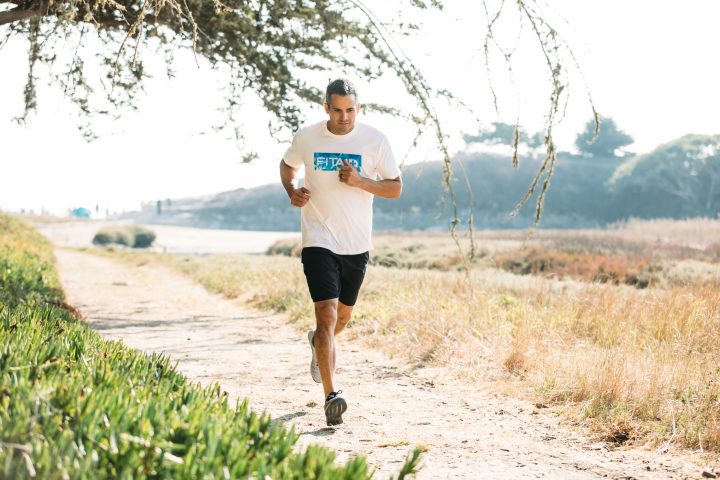
You may be thinking, “Why the heck would I give thanks for this hard situation or that difficult person?” These situations and individuals obviously provoke a negative emotional response of anger, frustration or even pain.
But if we peel back the initial emotionally charged layer, there is typically a virtue hiding right underneath the surface, a lesson that will allow us to elevate beyond the anger or frustration to a place of gratitude. We can be thankful for the difficult situation or person who helps teach us to be be more patient, selfless or kind. These virtues of acceptance, patience, humility and unconditional love help fuel us to be the best version of ourselves. As Tony Robbins says, “Life is not happening to us, it’s happening for us.”
So the next time we find ourselves in a challenging situation or with a difficult person (maybe at the Thanksgiving dinner table), let’s move quickly past any negative initial gut reaction and on to the deeper understanding of gratitude, realizing the ultimate lesson these situations and individuals and there to teach us.
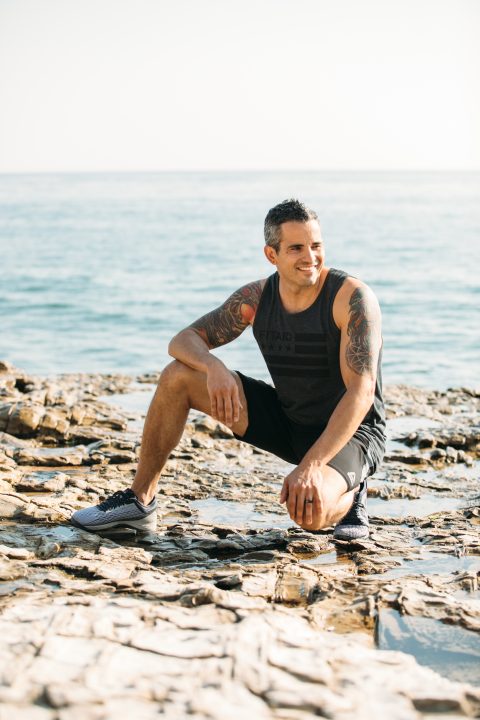 I know it may be counter-intuitive, but the most rewarding depths of gratitude often come from those moments we would be least likely to offer thanks for at first glance.
I know it may be counter-intuitive, but the most rewarding depths of gratitude often come from those moments we would be least likely to offer thanks for at first glance.
It is the lessons born from those challenging situations or people—teaching us, helping us to grow and become better versions of ourselves—which is where true gratitude resides.
May your holiday season be filled with gratitude and opportunities to give thanks, equally in both the easy and challenging moments of your life.
To learn more about Aaron, follow @aaronhinde on Instagram.
> > > Live well!
Gratitude … and giving thanks are always topical around the holiday season. It’s a perfect opportunity for us to reflect on the multitude of blessings we have in our lives including family, friends, work, health … On the flip side, it is much less intuitive to be grateful for the difficult situations and challenging people […]
